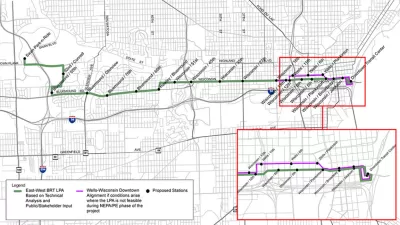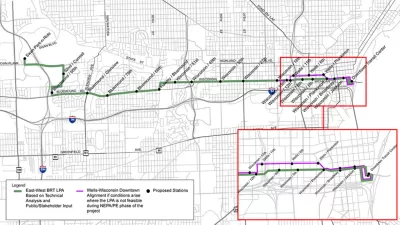The proposed East-West Bus Rapid Transit project has already built the political support that doomed a previous attempt at light rail along the corridor.

Bruce Murphy reports on a proposed bus rapid transit line in Milwaukee, on the "heavily trafficked, east-west corridor from downtown Milwaukee to Wauwatosa, parallel to I-94." According to Murphy, former Milwaukee Mayor John Norquist proposed a light rail line along the corridor, "but Waukesha County politicians adamantly and successfully opposed it."
"Now we have a proposal to create an nine-mile BRT or Bus Rapid Transit line," reports Murphy, "championed by Milwaukee County Executive Chris Abele, and the response is radically different, suggesting this proposal could succeed."
The article offers an introduction to the concept of Bus Rapid Transit, assuming there are readers in the Milwaukee area who might not be familiar with the quickly growing transit mode. Murphy also points to a model for the proposed Milwaukee line: the 7.1-mile Healthline in Cleveland, which opened in 2008 and "has generated $6.3 billion in new development along the line, including 7,200 housing units," according to Murphy.
The Milwaukee County Transit System has already completed a study of the proposed BRT route, plotting a potential 19 stops, daytime headways of ten minutes, and an estimated price tag of $42 million to $48 million.
FULL STORY: Does Anyone Oppose Bus Rapid Transit?

Planetizen Federal Action Tracker
A weekly monitor of how Trump’s orders and actions are impacting planners and planning in America.

Restaurant Patios Were a Pandemic Win — Why Were They so Hard to Keep?
Social distancing requirements and changes in travel patterns prompted cities to pilot new uses for street and sidewalk space. Then it got complicated.

Map: Where Senate Republicans Want to Sell Your Public Lands
For public land advocates, the Senate Republicans’ proposal to sell millions of acres of public land in the West is “the biggest fight of their careers.”

Maui's Vacation Rental Debate Turns Ugly
Verbal attacks, misinformation campaigns and fistfights plague a high-stakes debate to convert thousands of vacation rentals into long-term housing.

San Francisco Suspends Traffic Calming Amidst Record Deaths
Citing “a challenging fiscal landscape,” the city will cease the program on the heels of 42 traffic deaths, including 24 pedestrians.

California Homeless Arrests, Citations Spike After Ruling
An investigation reveals that anti-homeless actions increased up to 500% after Grants Pass v. Johnson — even in cities claiming no policy change.
Urban Design for Planners 1: Software Tools
This six-course series explores essential urban design concepts using open source software and equips planners with the tools they need to participate fully in the urban design process.
Planning for Universal Design
Learn the tools for implementing Universal Design in planning regulations.
Heyer Gruel & Associates PA
JM Goldson LLC
Custer County Colorado
City of Camden Redevelopment Agency
City of Astoria
Transportation Research & Education Center (TREC) at Portland State University
Camden Redevelopment Agency
City of Claremont
Municipality of Princeton (NJ)





























